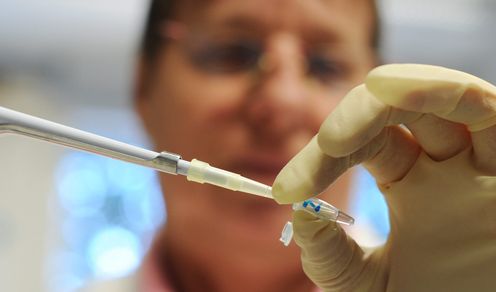
The idea of research reducing health-care costs may seem counter intuitive because it often leads to the development of expensive drugs, technologies, and treatments.EPA/ANGELIKA WARMUTH
Quality health care can be expensive and medical research has traditionally been thought to play a role in making it so. But research can also help cut the cost of medical care.
The notion of research reducing health-care costs may seem counter intuitive. After all, it’s expensive to do and, when it’s done well, it can lead to even more costs with the development of drugs, technologies, and treatments that are increasingly expensive.
But medical research can also cut health-care costs by hunting out existing treatments that work no better than placebos, identifying the treatments that work better than others, those treatments that have been superseded and those that cause more harm than good.
This research can often be just as transformative for both health outcomes and costs as new breakthroughs. And Australian researchers are already very good at it.
Here are just two instances of how our researchers have exposed ineffective health practices.
Cementing the science
On the face of it, it seems logical that stabilising cracked vertebrae by applying a “cement” to the fracture to keep the bone supported is useful. Unfortunately, this turned out not to be the case when this procedure was studied in a rigorous clinical trial in 2009, led by Professor Rachelle Buchbinder.
Before this research, many studies had looked at the effectiveness of vertebroplasty, but all had methodological weaknesses. None had “blinded” participants, where patients do not know if they have received treatment or not, nor a sham control procedure to compare effects against.
Without these, researchers could not eliminate the possibility that any noticeable improvements were the result of the placebo effect, where patients show improvement simply because they think they have received care, or a range of other effects that control groups can eliminate.
Despite these shortcomings, clinicians started performing the surgeries and public institutions around the world recommended the treatment for reimbursement, resulting in a dramatic increase in the number of vertebroplasties performed.

To test the procedure, the research team performed a study where 38 participants received vertebroplasty and 40 others received a sham surgical procedure (where a needle was inserted but no cement was used). Neither the patients nor the follow-up doctors knew whether the patient had received actual vertebroplasty.
One week later, there was no significant difference between the two groups. Nor was there a difference in follow-ups six months later, or even two years later. Vertebroplasty didn’t work.
The team faced opposition to their experiment – some opponents claimed it was unethical to perform a sham procedure in light of published results suggesting vertebroplasty was beneficial. But their work shows the hazards of relying on results of poorly-controlled studies to assess treatment efficacy.
The implications for health costs were considerable: 725 vertebroplasty procedures had been reimbursed in Australia, at the cost of around $1.15 million in 2009 alone.
The saline solution
Some years ago, a team of Australian researchers led by Professor Simon Finfer showed that use of cheaper saline solutions to replenish fluids in intensive care was at least as effective, and possibly safer, than more expensive albumin solutions.
In 2004, no randomised controlled trials had been conducted to determine whether the choice of intravenous fluid in intensive care units made a difference to health outcomes.
But meta-analyses of existing research had been done, with much conflict in the results. A Cochrane review found albumin solutions resulted in a 6% percent increase in risk of death. But another found no such risk.
And so began the Saline versus Albumin Fluid Evaluation, or SAFE study. Just under 7,000 patients were enrolled in the trial, and each was randomly assigned to receive either 4% albumin, or normal saline.

The study found that, for most patients in intensive care, there was no significant difference in the number of deaths or of organ failure between albumin or saline 28 days after treatment.
The official finding was that:
albumin and saline should be considered clinically equivalent treatments for intravascular volume resuscitation in a heterogeneous population of patients in the ICU.
But although they were “clinically equivalent”, the same could not be said for the cost of each treatment: saline costs $1.60 per litre – albumin costs approximately $332 a litre.
A subsequent Access Economics report found that if practices switched fluids, they would reap a net benefit of around $687 million per annum.
Keeping the courage
And there are many other studies like these.
Australian researchers have shown that we waste huge amounts of money on over-prescribing antibiotics; that patients with lower back pain were being unnecessarily referred for X-rays leading to high care costs; that cheaper local anaesthetics result in less morbidity and mortality than general anaesthetic for surgery; and that chest X-rays offer little benefit for emergency patients suffering acute coronary syndrome.
Each of these findings saved our health system hundreds of thousands of dollars.
Of course, identifying problems is only part of the solution. We also need policies that implement what research like this has found and change the way health care is practiced – and funded.
Vertebroplasty was removed from the Medicare Benefits Schedule in 2011 but many ineffective practices linger on.
Medical research can give us breakthrough treatments, but it can also play a role in creating a more sustainable health system by culling treatments that don’t work. It’s imperative that research, practice and policy work together to remove such treatments.
To do it will take courage; vested interests benefit from the status quo. But change is inevitable.
Editor’s note: Warwick Anderson will be answering questions about this article between 4:30 and 5:30pm AEST today (July 28). Please post queries below.
Warwick Anderson is the CEO of the National Health and Medical Research Council (NHMRC). The two case studies in this article were funded by the NHMRC.
